我们相信STEM这个词大家并不陌生,它是S-Science科学、T-Technology技术、E-Engineering工程、M-Mathematics数学的缩写。朝阳凯文学校一直致力于发展STEM的教学,校内优秀的老师们带领出色的学生不断探索,共同体验STEM课程。我们知道,STEM课程充满了整合性、实践性、趣味性及创造性,那么它到底能带来什么样的教学成果呢?
2019年3月,我们收到了一个令人振奋的消息,就在本月的第二周,Edward Gasanoff教授、凯文教育集团课程研究员李峰老师和朝阳凯文学校九年级学生Zhengyao Chen,与两所美国大学的合作发布了一篇研究论文,该文章发表在Toxins期刊上——该期刊在研究自然界天然毒素的生化分子机制以及医学应用领域内具有很高的影响力。
Edward教授和李峰老师从2018年秋季开展了生物化学分子工程方向的教学,项目内的学生深入学习了化学键、大分子空间结构、分子间相互作用和大分子的结构-功能关系背后的物理化学原理,这些也是IBDP科学课程中最难理解的概念。学生还通过该项目参与了与美国两所大学,内华达大学医学院和匹兹堡大学合作的科学研究,论文的发表是项目开展的初步成果。
很荣幸,我们邀请到了这两位老师,他们热情地为我们分享他们在STEM项目的教学经验和未来的培养计划。
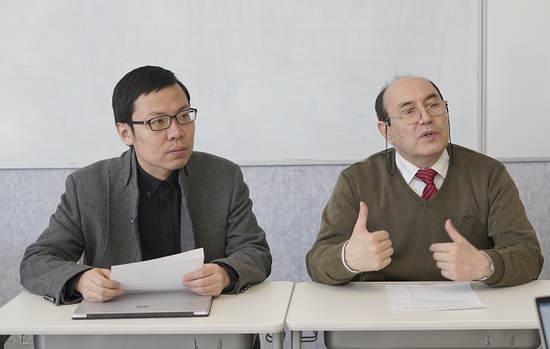
记者:两周前,朝阳凯文学校与两所美国大学合作,在一家在其专业领域内有很高影响力的科学期刊上发布了论文。这对于CKWA这一所K12学校来说具有非常重要的学术意义。 鉴于本文的作者之一是朝阳凯文的中学生,这使得本次论文的发表成为中学教育领域的极具价值的事件。 您同意我的想法吗? 如果是的话,我们想请您谈谈这篇文章的发表对于我们CKWA有怎样的意义?
Edward Gasanoff:是的,我同意你的观点。虽然朝阳凯文学校不是一所大学,但它可能是第一所能让其中学生参与美国大学一线生物化学研究的学校。 我们朝阳凯文学校的学生为这项研究作出了不少贡献,因此可以在发表的科学论文上署名,论文发表的期刊在其领域内有很高的影响力。
李峰:本次论文的发表,表明我们朝阳凯文学校有着非常优秀和努力的学生,也有一群非常专业,有着很高学术造诣的教师。我们教师的学术水准可以与美国大学的专业研究人员合作,指导学生参与真实的科研活动。我们学校有着对科学充满热情的学生、专业的教师以及与美国大学实验室的合作机会。这些都表明有深度的研究不是仅仅只有在大学才能开展,朝阳凯文学校也同样具备培养学生科学研究能力的条件和学术水平,这也是我们学校办学特色之一。
记者:研究性项目中培养的综合能力如何使CKWA的学生受益?
Edward Gasanoff:CKWA在中学阶段开设剑桥国际课程(CIE),即将在高中开设国际文凭课程(IBDP)。 CIE和IBDP都是高水平和具有挑战性的课程,IBDP特别强调考察学生的批判性思考能力、分析能力以及独立研究的能力。例如,Extended essay就通过写论文的形式考察学生的研究性学习的能力。这其实非常具有挑战性,因为一篇严谨的科学论文的写作不仅需要高水平的学术写作能力,还需要很强的数据分析、展示、论述和总结能力。因此,在CKWA开展的参与大学科研的STEM项目,对于学生IBDP的学习,也会有很大帮助。
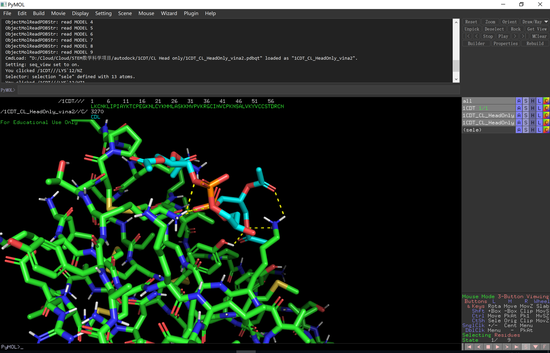 (图一:Pymol 1CDT pc head 作用位点分析)
(图一:Pymol 1CDT pc head 作用位点分析)记者:您是如何培养STEM项目组的学生参与Dagda博士实验室的科学研究的?
Edward Gasanoff:在参与研究之前,我们首先教授了一些基础的理论, 我们尝试为这个项目专门开发了一个课程。 课程包括原子结构和电子排布,离子键和共价键的化学键理论,鲍林的电负性理论,极性和非极性共价键理论,分子间的相互作用:离子键,极性共价键、氢键以及范德瓦尔斯力,生物分子三维结构的物理化学分析,以及某些特殊的分子间相互作用。 后面的课程我们则专注于生物大分子空间结构的计算机模拟,以及生物分子的对接计算。 Dagda博士是美国内华达州的STEM权威,正在协助复查我们的STEM课程,我们有计划未来一起把课程发表在美国的“STEM Outreach”期刊上。
李峰: 我们目前正在教我们的STEM学生学习使用Auto Dock Vina程序将毒素蛋白质与磷脂进行对接计算,并分析磷脂分子在蛋白质分子表面上的结合位点以及分子间作用力的类型。我们用计算机静态计算所获得的结果与Dagda博士、Gasanoff博士和Shrivastava博士实验室获得的实验结果能比较好的吻合,于是我们就在Toxins上一起合作发表了论文。
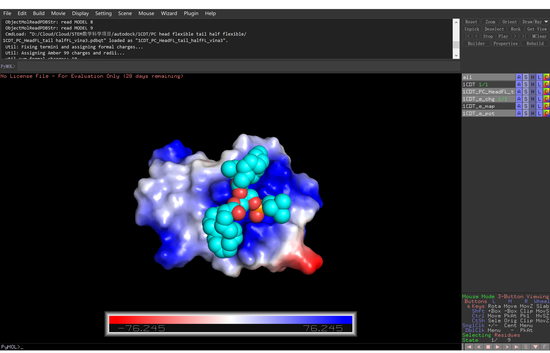 (图二:Pymol 1CDT PC相互作用)
(图二:Pymol 1CDT PC相互作用)记者:未来您对该项目的授课计划是什么呢?
Edward Gasanoff:明年我们将继续教授我们STEM的学生通过计算机3D建模程序来分析生物大分子。 此外,我们将邀请另一位CKWA老师William Xu和我们一起,他将教授我们的学生计算机编程的基础,以及如何用物理公式描述生物分子的生理行为。 如何用物理公式来描述生物大分子生理行为是一项艰巨的任务,这可能只能由该领域的少数科学家才能完成,我们这里将只教授一些基础知识,以便于我们的STEM学生未来在大学或者研究生阶段深入学习研究这个领域。 上述技能在生物分子工程的物理和化学机制研究中非常重要,这是现代科学技术的最新趋势。
李峰:在我们开展的项目中,我们做了从10-12年级三年的学习计划。10年级我们将我们的授课内容作为IGCSE科学课程的补充。11年级是IBDP课程的第一年,我们将补充学习计算机编程以及生物分子结构的物理特征和生理学意义。 12年级是IBDP科学课程的第二年,我们的课程除了补充DP科学的学习,研究项目还可以作为Extended Essay的研究主题。 我们希望未来深度的发展朝阳凯文学校的STEM课程,我们的项目也得到了内华达大学里诺医学院药理学系Ruben Dagda博士的热情支持,他将会为我们提供更多的合作研究、学生指导和交流学习上的机会。如果我们的项目开展顺利的话,未来我们还会考虑邀请莫斯科大学的博士后教授我们的学生高级计算机编程。我们希望有更多的热爱科学,并且希望在科学领域发展的优秀学生加入我们朝阳凯文学校的STEM项目。
记者:我们的STEM项目会在学生大学专业选择和未来的工作选择中提供帮助吗?
Edward Gasanoff:生物化学工程和人工酶的领域在未来有着广阔的发展前景的科学前沿,我们目前开展的项目希望为有志于在这个领域发展的学生打好基础。对整个人类来说,我们未来面临着人口指数增长所带来的巨大人口压力,这个领域的研究进展有望帮我们解决这个重大问题,目前美国的顶尖大学和俄罗斯的莫斯科大学都在致力于这个领域的研究。 我们开展的STEM项目希望培养有有兴趣的优秀学生进入世界顶尖大学以从事这个领域的研究。
李峰:生物化学工程和人工酶这个领域在解决能源危机,食物短缺以及环保产品的生产上有着非常大的应用价值。其中一些技术的开发,例如如何应对气候变化,目前梅琳达和比尔盖茨基金会也在资助这方面的研究。未来对这个领域的人才将会有很大的需求。
记者:STEM项目是如何与CKWA相辅相成的?
Edward Gasanoff:我们的STEM项目致力于培养对科学有着极大兴趣并且希望在科学领域发展的优秀学生。这对学校良好学习风气的建立会有着非常积极的作用。在我们的项目中,学生有机会参与一线科学研究领域,也有机会署名发表研究论文,这显然有助于我们的毕业生进入世界顶尖大学,也有助于建立我们凯文学校在学术上的口碑。
记者:听完两位老师的介绍,我们受益匪浅,并对那位深入参与了研究项目的九年级同学Zhengyao Chen产生了浓厚的兴趣,请两位老师简单评价一下他吧?
Edward Gasanoff :Zhengyao Chen是一个非常有才能的学生,他很好学并且也有很强的学习能力。他在这个年纪,就已经可以理解很多这个领域内相当于大学本科水平的知识。目前我们正在教他学习更多的科学概念,以及一些真实的科学实验室需要的研究技能。我们期待他未来有机会进入世界顶尖大学并成为某个科技领域的专家。
李峰:从去年开始,我在凯文的STEM项目中和Edward教授一起教Zhengyao Chen分子生物工程的知识,Zhengyao Chen是个好奇心很强,悟性很高,并且主动性很强的优秀学生,他能很快理解生物化学上有深度的知识,掌握计算机模拟和数据分析的一些技巧。让我更看重的,他也是个很懂事、很正直的孩子。我非常希望Zhengyao Chen未来能够继续在这个方向上深入学习发展,甚至有机会做出一些重要的研究突破和进展。
我们非常感谢两位老师对本次采访的大力支持,他们的回答解决了我们大部分的困惑,并为朝阳凯文学校未来在STEM项目上的发展提供了极为建设性的帮助。据几位神秘的STEM项目组成员介绍,朝阳凯文正在朝着更远的科学课程迈进,他们认为在不久的将来,STEM课程将会在培养中国新型人才上起到举足轻重的作用,在未来,更为复杂的社会网络与更加庞大的科技世界需要大量的跨学科人才,我们将竭尽全力承担起这样的教育责任。
Development of STEM at CKWA
Dr. Edward Gasanoff, a chemistry teacher at the Chaoyang KaiWen Academy (CKWA), and Mr. Feng Li, a curriculum researcher at the KaiWen Education Group, have launched an advanced STEM program for the secondary school students in the CKWA in the Fall semester of 2018. The aim of the STEM program was to advance understanding of the CKWA students in physics and chemistry of chemical bonding, macromolecular spatial structure, intermolecular interactions and structure-function relationships of macromolecules – the most difficult concepts of the IBDP science courses – and to involve the CKWA students in the collaborative scientific research studies with the two US universities, the Nevada University Reno Medical School and the Pittsburg University. In the second week of March 2019, a collaboration of the STEM program of CKWA with the two US universities has produced a research article which was published in Toxins – a high impact peer-reviewed scientific journal in area of biochemical and biomedical molecular mechanisms of natural toxins. Dr. Edward Gasanoff and Mr. Feng Li have been interviewed by the marketing department of the KaiWen Education Group in the regard of this publication.
Interviewer: Two weeks ago, the Chaoyang KaiWen Academy (CKWA) – one of the schools of the KaiWen Education Group – has published a scientific research article in collaboration with the two US universities in a highly influential academic journal. This collaboration has significant academic meaning for a K12 school like CKWA. Given that one of the authors of this article is complete by a CKWA secondary school student, this makes this publication became a huge news in the field of secondary education. Would you agree with me? If yes, please tell us what this publication has published is meaning for the CKWA?
Edward Gasanoff: Yes, I do agree with you. As you know the CKWA is not a tertiary education, however as far as I know the CKWA is possibly the first secondary school in China which has involved its secondary school students in the front line biomedical chemistry research together with US universities. The students of CKWA made an ample contribution to this research, therefore one of the students allowed to co-authored this research article in a high impact peer-reviewed scientific journal in area of biochemical molecular toxicology.
Feng Li: This publication not only showing that the student of CKWA are outstanding and hardworking, but also showing CKWA has the professional and highly skilled academic staff, which capable of guiding the students' research activities in a real scientific research environment in collaboration with the researchers from the US universities. The CKWA have science motivated students, a highly skilled science academic staff, plus the chance of in collaboration with the front-line US research laboratories – all these represent the research activity is not only for tertiary institutions, the CKWA also have the ability to educate student with the same scientific and academic level , which is also an unique signature feature for the school.
Interviewer: How does this blend of skills and capabilities benefit the CKWA students?
Edward Gasanoff: The CKWA runs the Cambridge International Examinations (CIE) curriculum in its secondary school and is about to start the International Baccalaureate Diploma Programme (IBDP) in its high school. Both CIE and IBDP are exceptionally advanced and challenging educational programs and IBDP is particularly rigorous in its assessment of students’ critical and analytical thinking skills and independent research skills. This is assessed through the external evaluation of the students’ research study skills in a form of extended essay, which is a very challenging task particularly in sciences where the extended essay requires not only a high level of academic writing, but also an exceptional research data presentation, analysis, discussion and conclusion at a level of scientific article. We use the skills and capabilities we have in the CKWA to run the STEM program in which we prepare our students for the IBDP extended essay projects by involving the students in the university scientific research projects.
Feng Li: In our STEM program we align the research activities of students with the research projects run in the laboratory of Dr. Ruben Dagda, a professor at the Pharmacology Department of the Nevada University Reno Medical School. Dr. Dagda studies molecular mechanisms of neurodegeneration. One of his particular interests relates to the changes in membrane structure of mitochondria in neural cells which course neurodegeneration. Dr. Dagda employs cobra venom cardiotoxins, which target mitochondria, to probe the structure and functions of mitochondrial membranes. We involve our STEM students in the Dr. Dagda research studies, and we make sure that the academic level of the students’ research is high enough that it can contribute to the scientific merit of the Dr. Dagda’s research so it can be published in the peer-reviewed scientific journals. We believe that the STEM students who succeed to publish a scientific article has had developed a high level of critical and analytical thinking skills and independent research skills to complete an excellent extended essay by the IBDP criteria.
Interviewer: How do you teach the STEM students so they can participate in the scientific research carried out in the Dr. Dagda’s laboratory?
Edward Gasanoff: We first start with the theory before we involve our students in the relevant research studies. We have developed a curriculum for the first year STEM program which we are test running at the moment and will complete it in about two months. The curriculum includes atomic structure with electron configurations, chemical bonds with particular emphasis on ionic and covalent bonds, Pauling’s theory of electronegativity with emphasis on polar and non-polar covalent bonds, intermolecular interactions in terms of ionic, polar and hydrogen bonds, and wan der Waals forces, physics and chemistry of 3-D structure of biomolecules and particular types of intermolecular interactions. After that, we have focused on computer modeling of spatial structure and docking of biomacromolecules. Dr. Dagda, who is a STEM authority in the state of Nevada in the USA, is reviewing our STEM curriculum and we are going to jointly publish it the “Journal of STEM Outreach” in the USA.
Feng Li: Dr. Dagda and Dr. Indira Shrivastava from the University of Pittsburg sent us digital files of several protein cardiotoxins and phospholipids found in mitochondrial membranes. We are currently teaching our STEM students to dock protein cardiotoxins with phospholipids using AutoDock Vina program and analyze types of intermolecular bonding and the binding sites on the molecular surface of proteins. The results of our computer modeling studies on one particular cardiotoxin aligned well with experimental results obtained in laboratories of Dr. Dagda, Dr. Gasanoff and Dr. Shrivastava, and we have published an article in Toxins describing our collaborative results.
Interviewer: What are you going to teach the STEM students next year?
Edward Gasanoff: Next year we will continue teaching the STEM students computer modeling programs for analysis of biomacromolecules. In addition, we will involve William Xu, another CKWA teacher, who will teach STEM students computer programming aligned with physiological behavior of biomolecules in terms of physical formulas. Describing physiological behavior of biomacromolecules in terms of physical formulas is a difficult task which is done by a very few scientists in the field, and we will touch only bases here so the STEM students get the basic skills in this field which they will further develop in the university and after university studies. These skills are very important in the physics and chemistry of biomolecular engineering which is the newest trend in modern science and technology.
Feng Li: In our project, we prepared our three years STEM study plan for Grades 10, 11 and 12 students. In the Grade 10 the STEM curriculum that we have already covered this academic year will supplement IGCSE curriculum. In the Grade 11 we will supplement the first year IBDP sciences curricula with the computer programming and physics and physiology of biomolecular structure. In the Grade 12 we will enrich the second year IBDP sciences curricula with the research studies related to the extended essay projects. The STEM program at the CKWA will be dynamically developing and will be supported by Dr. Ruben Dagda of the Pharmacology Department of the Nevada University Reno Medical School in terms of scientific research collaboration, students mentoring and exchange. Should the STEM developing successfully, in the second three-years cycle of STEM we may consider recruiting a post-doc from the Moscow State University to teach STEM students advanced computer programming. We hope that more outstanding students who passionate about science and hoping to develop themselves in the field of science will join CKWA STEM program.
Interviewer: Will the STEM program help the students with choosing the field of studies in university and with the job quests after the students graduate a university?
Edward Gasanoff: The CKWA STEM aims at fostering the skills needed in biochemical engineering and artificial enzymes which are the newest directions in the cutting-edge science focused at developing the technologies of the future. The questions with the development of these technologies, which are to mitigate the looming challenges of exponentially growing human population, are being currently addressed only by the top universities in the USA and the Moscow State University in Russia. We prepare our advanced STEM students to enter the top world universities to pursue the careers in the field of biochemical engineering of biomolecules and artificial enzymes.
Feng Li: In our current STEM program of CKWA ,we aim at developing the skills which will steer our students’ interest towards biochemical engineering and artificial enzymes which will develop new technologies to solve energy problems, shortage of food, environmentally friendly goods production and etc. Development of some of these technologies, such as dealing with the climate change for example, are currently funded by the Melinda and Bill Gates Foundation. The skills in this kind of science and technology are in a big demand now and will be in even greater demand in foreseeable future.
Interviewer: How will the STEM program help in advancing the reputation of the CKWA?
Edward Gasanoff: Our STEM program aimed at attracting the science motivated and academically advanced students to the CKWA. It is a well-known fact that any new academically advanced student always adds a positive dynamics to the efficient learning in a class. The STEM is designed to promote the students scientific research to be published in the high impact peer reviewed journals which will obviously help the advanced CKWA students to enter the top world universities. Altogether the STEM will advance the reputation of the CKWA as a school of the high academic excellence.
Interviewer: Zhengyao Chen is a student from the CKWA STEM program who has co-authored the article published in Toxins. Could you give us your comment on Zhengyao Chen?
Edward Gasanoff: Zhengyao Chen is a very exceptional student. He is very studious, and he has development excellent learning skills. At his age he can already understand material that is taught at the undergraduate university level. At the moment we are working with him on the science concepts and methods used in the real scientific laboratory environment. He has a high chance of entering to one of the top world universities and later become one of the high-level experts in the field of science and technology.
Feng Li: Since last year, I have been teaching Zhengyao Chen together with Professor Edward in our STEM project. Zhengyao Chen is an excellent, motivated student with strong curiosity. Zhengyao Chen was able to quickly understand the key concepts in Biochemistry and pick up the essential skills of computer simulation and data analysis. What I value more is that he is also a mature and upright person. I hope Zhengyao Chen will focus on this field, gain deeper understanding and maybe eventually have the chance to make some important breakthroughs in the research of this field.
想让娃出国留学,国际学校怎么选?新浪国际学校择校巡展了解一下!3月-5月,北京、上海、广州、深圳、杭州、成都多地联动!国内百所国际学校的盛宴,众多顶尖海外名校鼎力加盟!一对一现场咨询、面试!还等什么?快来扫码报名吧!






 剑桥校长:接受中国高考成绩不是“抢生源”
剑桥校长:接受中国高考成绩不是“抢生源”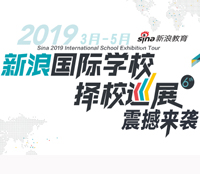 别信“国外孩子整天玩” 美国妈妈也在推娃
别信“国外孩子整天玩” 美国妈妈也在推娃 2019高考大本营 每个考生必备的“秘密武器”
2019高考大本营 每个考生必备的“秘密武器”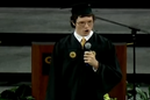 美国大学激情迎新演讲
美国大学激情迎新演讲 十分钟趣味世界历史
十分钟趣味世界历史 60秒动画读懂经济学
60秒动画读懂经济学 意大利美食烹饪入门
意大利美食烹饪入门 新浪2018教育盛典聚焦“融”
新浪2018教育盛典聚焦“融” 2018新浪五星金牌教师颁奖典礼
2018新浪五星金牌教师颁奖典礼 GoodTalk国际青少年双语演讲大会
GoodTalk国际青少年双语演讲大会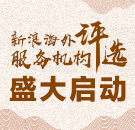 第八届新浪海外服务机构评选活动盛大启动
第八届新浪海外服务机构评选活动盛大启动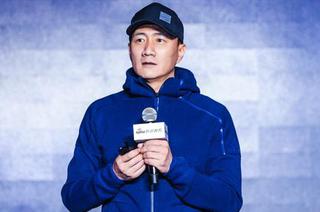 胡军:用心陪伴是给孩子最好的教育
胡军:用心陪伴是给孩子最好的教育 田朴珺:什么是真正的贵族教育
田朴珺:什么是真正的贵族教育 张怡筠:家庭教育要从情商教育开始
张怡筠:家庭教育要从情商教育开始 朱永新:中国教育需要改革开放
朱永新:中国教育需要改革开放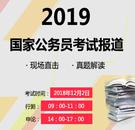 2019年国家公务员考试笔试报道
2019年国家公务员考试笔试报道 2019全国硕士研究生招生考试
2019全国硕士研究生招生考试 直击2017年6月大学英语四六级
直击2017年6月大学英语四六级 2017全国高考特别报道
2017全国高考特别报道